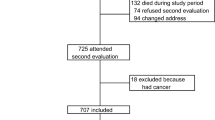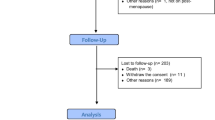Abstract
Summary
The Brazilian Osteoporosis Study (BRAZOS) is the first epidemiological study carried out in a representative sample of Brazilian men and women aged 40 years or older. The prevalence of fragility fractures is about 15.1% in the women and 12.8% in the men. Moreover, advanced age, sedentarism, family history of hip fracture, current smoking, recurrent falls, diabetes mellitus and poor quality of life are the main clinical risk factors associated with fragility fractures.
Introduction
The Brazilian Osteoporosis Study (BRAZOS) is the first epidemiological study carried out in a representative sample of Brazilian men and women aged 40 years or older with the purpose of identifying the prevalence and the main clinical risk factors (CRF) associated with osteoporotic fracture in our population.
Methods
A total of 2,420 individuals (women, 70%) from 150 different cities in the five geographic regions in Brazil, and all different socio-economical classes were selected to participate in the present survey. Anthropometrical data as well as life habits, fracture history, food intake, physical activity, falls and quality of life were determined by individual quantitative interviews. The representative sampling was based on Brazilian National data provided by the 2000 and 2003 census. Low trauma fracture was defined as that resulting of a fall from standing height or less in individuals 50 years or older at specific skeletal sites: forearm, femur, ribs, vertebra and humerus. Sampling error was 2.2% with 95% confidence intervals. Logistic regression analysis models were designed having the fragility fracture as the dependent variable and all other parameters as the independent variable. Significance level was set as p < 0.05.
Results
The average of age, height and weight for men and women were 58.4 ± 12.8 and 60.1 ± 13.7 years, 1.67 ± 0.08 and 1.56 ± 0.07 m and 73.3 ± 14.7 and 64.7 ± 13.7 kg, respectively. About 15.1% of the women and 12.8% of the men reported fragility fractures. In the women, the main CRF associated with fractures were advanced age (OR = 1.6; 95% CI 1.06–2.4), family history of hip fracture (OR = 1.7; 95% CI 1.1–2.8), early menopause (OR = 1.7; 95% CI 1.02–2.9), sedentary lifestyle (OR = 1.6; 95% CI 1.02–2.7), poor quality of life (OR = 1.9; 95% CI 1.2–2.9), higher intake of phosphorus (OR = 1.9; 95% CI 1.2–2.9), diabetes mellitus (OR = 2.8; 95% CI 1.01–8.2), use of benzodiazepine drugs (OR = 2.0; 95% CI 1.1–3.6) and recurrent falls (OR = 2.4; 95% CI 1.2–5.0). In the men, the main CRF were poor quality of life (OR = 3.2; 95% CI 1.7–6.1), current smoking (OR = 3.5; 95% CI 1.28–9.77), diabetes mellitus (OR = 4.2; 95% CI 1.27–13.7) and sedentary lifestyle (OR = 6.3; 95% CI 1.1–36.1).
Conclusion
Our findings suggest that CRF may contribute as an important tool to identify men and women with higher risk of osteoporotic fractures and that interventions aiming at specific risk factors (quit smoking, regular physical activity, prevention of falls) may help to manage patients to reduce their risk of fracture.
Similar content being viewed by others
References
Kanis JA, Oden A, Johnell O, Jonsson B, de Laet C, Dawson A (2001) The burden of osteoporotic fractures: a method for setting intervention thresholds. Osteoporos Int 12(5):417–427
Johnell O, Kanis J (2005) Epidemiology of osteoporotic fractures. Osteoporos Int 16(Suppl 2):S3–S7
Garcia R, Leme MD, Garcez-Leme LE (2006) Evolution of Brazilian elderly with hip fracture secondary to a fall. Clinics 61(6):539–544
Vidal EI, Coeli CM, Pinheiro RS, Camargo KR (2006) Mortality within 1 year after hip fracture surgical repair in the elderly according to postoperative period: a probabilistic record linkage study in Brazil. Osteoporos Int 17(10):1569–1576
Pinheiro MM, Castro CM, Szejnfeld VL (2006) Low femoral bone mineral density and quantitative ultrasound are risk factors for new osteoporotic fracture and total and cardiovascular mortality: a 5-year population-based study of brazilian elderly women. J Gerontol A Biol Sci Med Sci 61(2):196–203
Castro da Rocha FA, Ribeiro AR (2003) Low incidence of hip fractures in an equatorial area. Osteoporos Int 14(6):496–499
Silveira VA, Medeiros, Coelho-Filho JM et al (2005) Hip fracture incidence in an urban area in Northeast Brazil. Cad Saude Publica 21(3):907–912
Komatsu RS, Ramos LR, Szejnfeld VL (2004) Incidence of proximal femur fractures in Marilia, Brazil. J Nutr Health Aging 8(5):362–367
Abrahamsen B, Rejnmark L, Nielsen SP et al (2006) Ten-year prediction of osteoporosis from baseline bone mineral density: development of prognostic thresholds in healthy postmenopausal women. The Danish Osteoporosis Prevention Study. Osteoporos Int 17(2):245–251
Black DM, Steinbuch M, Palermo L et al (2001) As assessment tool for predicting fracture risk in postmenopausal women. Osteoporos Int 12:519–528
Siris ES, Miller PD, Barrett-Connor E et al (2001) Identification and fracture outcomes of undiagnosed low bone mineral density in postmenopausal women: results from the National Osteoporosis Risk Assessment. JAMA 286(22):2815–2822
Dargent-Molina P, Douchin MN, Cormier C, Meunier PJ, Breart G, and EPIDOS Study Group (2002) Use of clinical risk factors in elderly women with low bone mineral density to identify women at higher risk of hip fracture: The EPIDOS prospective study. Osteoporos Int 13(7):593–599
Henry MJ, Pasco JA, Sanders KM, Nicholson GC, Kotowicz MA (2006) Fracture Risk (FRISK) Score: Geelong Osteoporosis Study. Radiology 241(1):190–196
Black DM, Palermo L, Pearson J, Abbott T, Johnell O (1998) A simple, useful risk factor system can identify the large majority of women with osteoporosis. Bone 23(Suppl 5):605
Cadarette SM, Jaglal SB, Kreiger N, McIsaac WJ, Darlington GA, Tu JV (2000) Development and validation of the Osteoporosis Risk Assessment Instrument to facilitate selection of women for bone densitometry. CMAJ 162(9):1289–1294
Koh LK, Sedrine WB, Torralba TP et al (2001) Osteoporosis Self-Assessment Tool for Asians (OSTA) Research Group. A simple tool to identify Asian women at increased risk of osteoporosis. Osteoporos Int 12(8):699–705
Sen SS, Rives VP, Messina OD et al (2005) A risk assessment tool (OsteoRisk) for identifying Latin American women with osteoporosis. J Gen Intern Med 20(3):245–250
Kanis JA, Oden A, Johnell O, Johansson H et al (2007) The use of clinical risk factors enhances the performance of BMD in the prediction of hip and osteoporotic fractures in men and women. Osteoporos Int 18(8):1033–1046
Instituto Brasileiro de Geografia e Estatística 2000. http://www.ibge.gov.br/home/estatistica/populacao/censo2000/default.shtm
Pesquisa Nacional por Amostras de Domicílios 2003. http://www.ibge.gov.br/home/estatistica/populacao/trabalhoererendimento/pnad2003/coeficiente_brasil.shtm
Ware JE, Kosinski M, Dewey JE et al (2001) How to score and interpret single-item health status measures: a manual for users of the SF-8 Health Survey. Lincoln RI: Quality Metric Incorporated
Florindo AA, Latorre M do R, Jaime PC, Tanaka T, Zerbini CA (2004) Methodology to evaluation the habitual physical activity in men aged 50 years or more. Rev Saude Publica 38(2):307–314
Schwartz AV, Villa ML, Prill M et al (1999) Falls in older mexican-American women. J Am Geriatr Soc 47(11):1371–1378
Rodrigues Camargo MB, Cendoroglo MS, Ramos LR et al (2005) Bone mineral density and osteoporosis among a predominantly Caucasian elderly population in the city of Sao Paulo, Brazil. Osteoporos Int 16(11):1451–1460
Ramalho AC, Lazaretti-Castro M, Hauache O, Vieira JG, Takata E, Cafalli F, Tavares F (2001) Osteoporotic fractures of proximal femur: clinical and epidemiological features in a population of the city of Sao Paulo. Sao Paulo Med J 119(2):48–53
Pinheiro MM, Castro CH, Frisoli A, Szejnfeld VL (2003) Discriminatory ability of quantitative ultrasound measurements is similar to dual-energy X-ray absorptiometry in a Brazilian women population with osteoporotic fracture. Calcif Tissue Int 73(6):555–564
Siqueira FV, Facchini LA, Hallal PC (2005) The burden of fractures in Brazil: a population-based study. Bone 37(2):261–266
Albrand G, Munoz F, Sornay-Rendu E, DuBoeuf F, Delmas PD (2003) Independent predictors of all osteoporosis-related fractures in healthy postmenopausal women: the OFELY study. Bone 32(1):78–85
Taylor BC, Schreiner PJ, Stone KL et al (2004) Long-term prediction of incident hip fracture risk in elderly white women: Study of Osteoporotic Fractures. J Am Geriatr Soc 52(9):1479–1486
Robbins J, Schott AM, Azari R, Kronmal R (2006) Body mass index is not a good predictor of bone density: results from WHI, CHS, and EPIDOS. J Clin Densitom 9(3):329–334
Montilla RNG, Aldrighi JM, Marucci MFN (2004) Calcium/protein relation of women on the climacteric. Rev Assoc Med Bras 50(1):52–54
Lerner BR, Lei DLM, Chaves SP et al (2000) Consumption of calcium by adolescents from public schools em Osasco, São Paulo, Brazil. Rev Nutr 13(1):57–63
Saraiva GL, Cendoroglo MS, Ramos LR et al (2005) Influence of ultraviolet radiation on the production of 25 hydroxyvitamin D in the elderly population in the city of Sao Paulo (23 o 34¢S), Brazil. Osteoporos Int 16(12):1649–1654
Heaney RP (2001) Constructive interactions among nutrients and bone-active pharmacologic agents with principal emphasis on calcium, phosphorus, vitamin D and protein. J Am Coll Nutr 20(5 Suppl):403S–409S
Miao J, Brismar K, Nyren O, Ugarph-Morawski A, Ye W (2005) Elevated hip fracture risk in type 1 diabetic patients: a population-based cohort study in Sweden. Diabetes Care 28(12):2850–2855
Carnevale V, Romagnoli E, D’Erasmo E (2004) Skeletal involvement in patients with diabetes mellitus. Diabetes Metab Res Rev 20(3):196–204
Pluijm SM, Smit JH, Tromp EA, Stel VS, Deeg DJ, Bouter LM, Lips P (2006) A risk profile for identifying community-dwelling elderly with a high risk of recurrent falling: results of a 3-year prospective study. Osteoporos Int 17(3):417–425
Takkouche B, Montes-Martinez A, Gill SS, Etminan M (2007) Psychotropic medications and the risk of fracture: a meta-analysis. Drug Saf 30(2):171–184
Florindo AA, Latorre M do R, Jaime PC, Tanaka T, Pippa MG, Zerbini CA (2002) Past and present habitual physical activity and its relationship with bone mineral density in men aged 50 years and older in Brazil. J Gerontol A Biol Sci Med Sci 57(10):M654–M657
Tanaka T, Latorre MR, Jaime PC, Florindo AA, Pippa MG, Zerbini CA (2001) Risk factors for proximal femur osteoporosis in men aged 50 years or older. Osteoporos Int 12(11):942–949
Lewis CE, Ewing SK, Taylor BC, Shikany JM, Fink HA, Ensrud KE, Barrett-Connor E, Cummings SR, Orwoll E and Osteoporotic Fractures in Men (MrOS) Study Research Group (2007) Predictors of non-spine fracture in elderly men: the MrOS study. J Bone Miner Res 22(2):211–219
Lazaretti-Castro M, Duarte-de-Oliveira MA, Russo EM, Vieira JG (1997) Vitamin D receptor alleles and bone mineral density in a normal premenopausal Brazilian female population. Braz J Med Biol Res 30(8):929–932
Barros ER, Kasamatsu TS, Ramalho AC, Hauache OM, Vieira JG, Lazaretti-Castro M (2002) Bone mineral density in young women of the city of Sao Paulo, Brazil: correlation with both collagen type I alpha 1 gene polymorphism and clinical aspects. Braz J Med Biol Res 35(8):885–893
Brenneman SK, Barrett-Connor E, Sajjan S, Markson LE, Siris ES (2006) Impact of recent fracture on health-related quality of life in postmenopausal women. J Bone Miner Res 21(6):809–816
Fechtenbaum J, Cropet C, Kolta S, Horlait S, Orcel P, Roux C (2005) The severity of vertebral fractures and health-related quality of life in osteoporotic postmenopausal women. Osteoporos Int 16(12):2175–2179
Kanis JA (1994) Assessment of fracture risk and its appication to screening for postmenopausal osteoporosis: synopsis of a WHO report. WHO Study Group. Osteoporos Int 4(6):368–381
Acknowledgements
This study was funded by a grant from Wyeth Healthcare Consumer.
Conflicts of interest
None.
Author information
Authors and Affiliations
Corresponding author
Rights and permissions
About this article
Cite this article
Pinheiro, M.M., Ciconelli, R.M., Martini, L.A. et al. Clinical risk factors for osteoporotic fractures in Brazilian women and men: the Brazilian Osteoporosis Study (BRAZOS). Osteoporos Int 20, 399–408 (2009). https://doi.org/10.1007/s00198-008-0680-5
Received:
Accepted:
Published:
Issue Date:
DOI: https://doi.org/10.1007/s00198-008-0680-5




